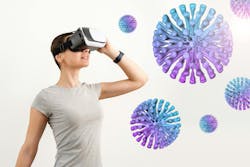Exploring the Latest in Extended Reality (XR)
What you’ll learn:
- What’s new in XR?
- What pitfalls to avoid when utilizing XR.
- What are some of the new XR display technologies?
EXtended Reality (XR), sometimes referred to mixed reality (MR), brings together digital twins, augmented reality (AR), and virtual reality (VR) technologies. It takes advantage of advances in optics, sensors, mobile computation engines, and now artificial intelligence and machine learning (AI/ML) to provide immersive environments that can be used for everything from industrial applications and product design to medical analysis and gaming.
Augmented World Expo’s (AWE) latest AWE USA 2024 conference just wrapped up and I missed it. Never fear, they recorded almost all of it on the AWE YouTube channel. It might take a couple days to watch it all, but I cherry-picked a few here that target trend and implementation details, which I think engineers and programmers would be most interested in. Check out the XR Policy and XR in the Enterprise channels for some of the other videos.
Most of the videos I've chosen are from the XR Enablement section, which had over two dozen sessions:
- Current State and Future Direction of AR Glasses
- Uphill, BOTH WAYS – The Anatomy of Enterprise XR Breakthroughs
- 5 Biggest Pitfalls Industrial SMEs Should Avoid when Adding XR to their Business
- Leveling up AR Waveguide Displays
- Harnessing the Power of Retinal Eye Tracking for Enhanced XR Experiences
- Mixing in Reverse Optical Flow to Mitigate Vection and Simulation Sickness in Virtual Reality
Also check out our Mixing Reality TechXchange and our sister publication, Vision Systems Design. Leave a comment, we are interested in your feedback. Also, take our Quick Poll below, which is about XR.
Uphill, BOTH WAYS – The Anatomy of Enterprise XR Breakthroughs
Ryan Wheeler is a Senior Fellow in the Advanced Visualization group with Collins Aerospace. He has been working with all aspects of XR for a long time and talks about his experiences and insight into XR.
5 Biggest Pitfalls Industrial SMEs Should Avoid when Adding XR to Their Business
Harald Wuest is CEO and Founder of Visometry, a German-based company that delivers industrial augmented-reality solutions. He talks about the five biggest pitfalls that subject matter experts (SMEs) typically encounter when diving into the XR pool. Worth checking out before putting on a Meta Quest 3 or Apple Vision Pro.
Leveling up AR Waveguide Displays
Joshua Littlefield is president at Dispelix, a company that provides XR technology. The company's transparent waveguides are used as see-through displays in extended-reality (XR) devices. The waveguides optically combine the real and virtual worlds in the user’s field of vision. He talks about how waveguides work and where things are headed in the AR optical space.
Harnessing the Power of Retinal Eye Tracking for Enhanced XR Experiences
Eye tracking is becoming more common in XR implementations. Immersix’s Adam Dunsky starts with the basics and explains why it's superior to traditional control methods. He also talks about how it improves the user experience with XR applications.
Mixing in Reverse Optical Flow to Mitigate Vection and Simulation Sickness in Virtual Reality
Simulation sickness is the bane of XR and VR in specific. Minchae Kim and Jungha Kim work at the Digital eXPerience Laboratory (DXP Lab) in Korea. Their study showcases a method to reduce simulator sickness “by visually mixing the optical flow patterns that are in the reverse direction of the virtual visual motion.”
About the Author
William G. Wong
Senior Content Director - Electronic Design and Microwaves & RF
I am Editor of Electronic Design focusing on embedded, software, and systems. As Senior Content Director, I also manage Microwaves & RF and I work with a great team of editors to provide engineers, programmers, developers and technical managers with interesting and useful articles and videos on a regular basis. Check out our free newsletters to see the latest content.
You can send press releases for new products for possible coverage on the website. I am also interested in receiving contributed articles for publishing on our website. Use our template and send to me along with a signed release form.
Check out my blog, AltEmbedded on Electronic Design, as well as his latest articles on this site that are listed below.
You can visit my social media via these links:
- AltEmbedded on Electronic Design
- Bill Wong on Facebook
- @AltEmbedded on Twitter
- Bill Wong on LinkedIn
I earned a Bachelor of Electrical Engineering at the Georgia Institute of Technology and a Masters in Computer Science from Rutgers University. I still do a bit of programming using everything from C and C++ to Rust and Ada/SPARK. I do a bit of PHP programming for Drupal websites. I have posted a few Drupal modules.
I still get a hand on software and electronic hardware. Some of this can be found on our Kit Close-Up video series. You can also see me on many of our TechXchange Talk videos. I am interested in a range of projects from robotics to artificial intelligence.



